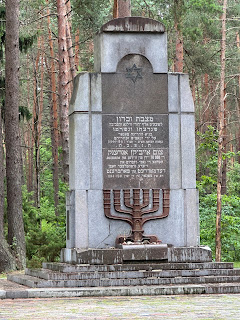We had a six-hour walking and driving tour of Jewish Vilnius that included Cathedral Square, the small and large ghetto, and the Paneriai Memorial, with our guide Svetlana, a young Jewish woman from Vilnius. Svetlana's mother was two-years old at the start of the war, and, when the ghetto was liquidated, they were able to get her out and into the home of a Polish family who raised her from 2 to about 6-years old. No one else in her family survived. When the war ended, the Lithuanian Jewish community wanted to give the children saved by Righteous Gentiles the chance to rejoin the community, so, her mother, like many others, was sent to a Jewish orphanage and raised in the religion of her birth. Her father, a Russian, survived because his father had endured the war as a member of the Soviet army. Today, her family, like most others in Vilnius, celebrates the Jewish holidays and consider themselves Jewish but do no participate in the only surviving synagogue, the Orthodox Vilnius Choral Synagogue where we attended services the prior evening.
Our tour started with a leisurely walk from our hotel to Cathedral Square and the Vilnius Cathedral. It might seem a strange place to begin, but our Svetlana wanted to show us an unusual statue for a Catholic cathedral -- Moses. The sculptor based his design on Michelangelo's Moses with the two horns, a misinterpretation of the Hebrew word cornuta, which means both horns and, according to our guide and other sources, rays of sun, a more likely translation.
The Stumbling Stones project has taken root all across Europe, including the Baltics. Memorial bronze tiles are placed in front of the homes or businesses of victims of the Holocaust. In this case, the stones which represent Lazar Lewando and Fania Lewando-Fiszelewicz sit in front of what used to be Fania's vegetarian restaurant, Dieto-Jarska, or Vegetarian Bistro. She was well known for her excellent cooking and compiled her recipes in a cookbook, Vegetarian Cookbook: 400 Meals Made Exclusively from Vegetables in 1938. The artist Marc Chagall signed a guest book. In 1941 Lazar and Fania attempted to escape the Nazis, only to be captured and killed, according to Svetlana. Other sources suggest they were captured by the Soviet army and that their fate is uncertain.
I was particularly intrigued to discover that, despite being horribly overcrowded, the ghetto had a library that also offered music, dance, theater, and lectures in addition to the books. Currently the building is under renovation to be turned into a local museum of the ghetto. In the exterior are enlarged photos found in the ghetto after its liquidation. Most of the people in the pictures have never been identified.
In addition to the library, the ghetto also had a secret synagogue. That building is no longer extant, but you can see the hand-carved Star of David on the concret part of the wall.
When the ghetto was liquidated the people were taken by truck about 20 minutes away to what was then the Ponary Forest, now the Paneriai Memorial. There the Nazis had discovered large pits used by the Russians to hold fuel and other materials, perfect for the mass graves. 70,000 Jews were murdered here along with 2,000 Poles, 8,000 Soviet POWs, and other people deemed traitors to the Germans.
The mass killings in Ponar were prior to the final solution of the concentrations camps and are not as well known. Here is a testimony from a gentleman who escaped. "Completely by Chance"
Although some of the pits were burned, remains still sit under the earth. In 2021 researchers used non-invasive geophysical methods to locate remains, as well as a tunnel that was used by those burning the pits to escape in the middle of the night. 12 of those prisoners were able to escape the forest.
The beauty and quiet of the forest belied its history. Our walk through the killing fields was emotional, and when we saw a local walking through the woods to gather fresh strawberries that fill the area, it simply felt wrong.
I am purposefully ending this post on a positive note. Here is one of the most famous individuals, at least to Canadians and Americans, with roots in Vilnius.


























No comments:
Post a Comment